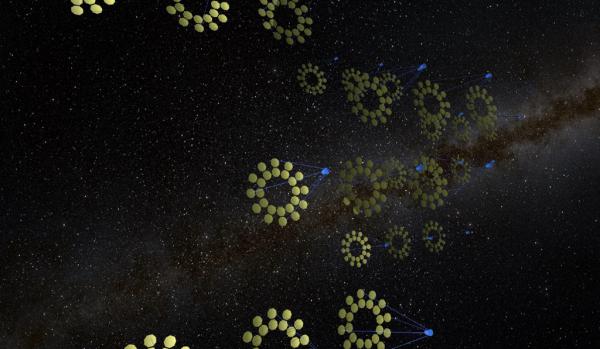BY LETTER
Eyes of Neptune, The
Ultra Long Baseline Virtual Space Telescope | |
 Image from Steve Bowers | |
| Two clouds of space telescopes located at Neptune's Trojan Points, constructed in the First Federation Era | |
The proposal for the Eyes of Neptune was made as part of the Council of Earth's Century 26 Plan, a list of scientific projects to be carried out during the 26th century of the Common Era. It was an extrapolation of the existing Eyes of Luna, which incorporated observatories at Earth-Luna L4 and L5, as well as several similar hypertelescopes elsewhere in the Solar System. This would allow for a much greater viewing area, as well as a longer baseline. However, the construction of the hypertelescope had barely begun when the Technocalypse and the subsequent Great Expulsion halted the project for over half a millennium.
The First Federation quickly revived the plan as part of its scientific ambitions. Two clouds consisting of millions of large telescopes with a total surface area of millions of square kilometres were manufactured and assembled in situ using materials from the local Trojan asteroids over a period of some two hundred years. The third cloud would later be constructed at Sol-Neptune L3 using materials from the Kuiper belt. First light was achieved on 7th Darwin, 1221 AT, when the Eyes of Neptune observed the white dwarf WD J0917+4638, and discovered the curious curlicues in this white dwarf's photosphere, which led to a re-evaluation of the physics of degenerate matter.
Starting in the late First Federation era, the Eyes of Neptune were superseded by several hypertelescopes constructed in other star systems, and when the Solsys Organisation was established, they were incorporated into the brand new Solsys Telescope Network. By 4000, the Eyes of Neptune were no more - successive centuries of upgrades and deployment of newer, larger swarms had replaced the ancient system. These new arrays would later be connected via wormhole to the nascent Argus Array.
Related Articles
- Argus Array
- Luna
- Neptune
- Solsys
- Trojan Asteroids - Text by M. Alan Kazlev
Asteroids caught near the Lagrangian points in a planet's orbit, 60° ahead of and 60° behind the planet. The original Trojans were connected to Jupiter's orbit, but the term is used to designate asteroids or other similar bodies in a relation to any large planet.
Appears in Topics
Development Notes
Text by Tom Mazanec, updated by The Astronomer in 2021
Initially published on 19 November 2015.
Initially published on 19 November 2015.






